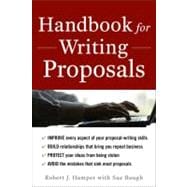Revised and updated!
Handbook for Writing Proposals gives proven techniques and practical advice for how to write winning business proposals, guiding readers through the entire proposal process, from initial contact witch potential clients to presenting a successful proposal.
Now with new information on budgeting and cost analysis, section on establishing credibility with clients, and new worksheets and checklists.
About the Book
Since 1995,Handbook for Writing Proposals(28,000 sold!) has helped thousands of professionals write and develop winning business proposals, offering readers a step-by-step guide from analyzing a Request for Proposal (RFP) to presenting the proposal and sealing the deal.
The huge changes taking place in the business world today offer an excellent opportunity to revise this textbook. More people than ever are launching their own businesses, recognizing that their former jobs may be gone for good. Current businesses are scrambling to retain old clients or acquire new ones. As a result, the competition for clients is fierce, and any company that knows how to respond to RFPs and develop a winning proposal is going to have a decided advantage.
Handbook for Writing Proposals can be their best guide in this process, helping them to navigate the confusing waters of how to understand what an RFP is asking for, how to build credibility with clients, how to design a winning program, and how to write and present a proposal that highlights how they will satisfy a client's needs.
The Handbook for Writing Proposals is still remarkably relevant given its original publication date in 1995. However, it does need some updating. In particular, the budgeting and cost information needs to be expanded, greater emphasis placed on establishing a firm's credibility, and more information provided on building value between the client and responding firm. A value-added component includes downloable forms and checklists that readers can use to begin their proposal-writing process.
''This book guides you through the process of creating the best impression of your sweat equity to your customer. Whether you need to polish up and improve every aspect of the proposal or just certain elements, this book will fill the need. Remember, the economics of gain only occur when a customer feels you’ve fulfilled a need and created value.'' --Paul V. Baron, President, In-Store Bakery Division, The Quarter Oats Company









